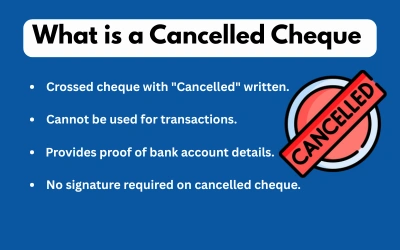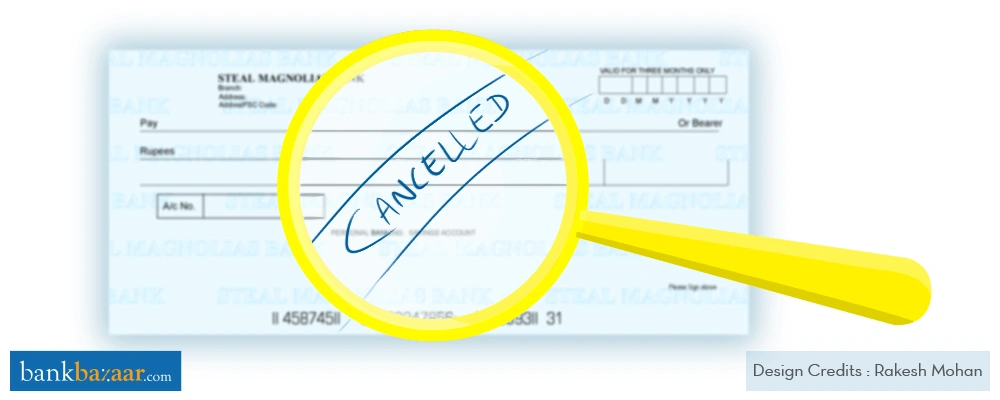What is a Cancelled Cheque
A cancelled cheque is a cheque that has been marked with two parallel lines and the word 'CANCELLED.' It is used in various banking and financial services as proof of account ownership. Learn more about its uses, and how to cancel a cheque safely.
The reason why you are asked to cancel the cheque is to make sure that it is not misused in any manner. Read on to know more about the uses of a cancelled cheque.

When Do You Need a Cancelled Cheque?
Many times you would have often come across the term 'cancelled cheque' while transacting in the bank. However, the use of cancelled cheques is not limited to banking transactions. Here we list out some of the common purposes of a cancelled cheque:
- You may be required to provide a cancelled cheque while opening a savings account or current account in the bank.
- Setting Electronic Clearance Service (ECS) from the account.
- You may require a cancelled cheque for KYC purpose. Nowadays, most investment firms require you to submit a cancelled cheque as part of KYC.
- For withdrawal of EPF funds.
- Financial lending organizations often ask borrowers for a cancelled cheque to process their loan request.
- When purchasing insurance policies such as endowment plan or money back plan, you may be asked to submit a cancelled cheque.
- You will be required to submit a cancelled cheque when opening a demat account.

How to Cancel a Cheque?
Step 1: Take a cheque leaf from your cheque book.
Step 2: Draw two parallel lines across the cheque.
Step 3: Write the word “CANCELLED” clearly between the two lines.
Step 4: Do not put your signature on the cancelled cheque.
Step 5: Remember that a cancelled cheque shows key account details such as:
- Account number
- Your name (as per the bank account)
- MICR code
- Bank name
- Bank branch
Step 6: Hand over the cancelled cheque only to a trusted person or institution, since it contains sensitive account information.
Risks Associated with a Cancelled Cheque:
It is important to note that though a cancelled cheque cannot be used for bank transactions, it contains sensitive and confidential information like the account holder’s name, banks details, etc. A cancelled cheque comes with certain risks as it can be used for fraudulent activities. Read n to know more about:
- Theft of Identity: A cancelled cheque contains crucial banking details like the account holder’s name, number, bank details. If obtained by someone with malicious intent, they could attempt fraud, such as opening accounts in your name or misusing your information for financial gain.
- Data Breaches: Even when given to trusted institutions or individuals, your cancelled cheques are not entirely risk-free. A data breach at their end could expose your sensitive information and make you more prone to scams.
- Unauthorised Use: While the cancelled cheque itself can’t be cashed, the details on it could still be misused for unauthorised online payments or transfers if not handled securely.
How to Minimise the risk of fraud associated with a Cancelled Cheque
It is important to keep your cancelled cheque safe to avoid any fraud or misuse. However, if you need to submit your cancelled cheque somewhere, it is essential to ensure that you take all the necessary precautions to avoid misuse. Read on to know more about the ways to minimise the risk of fraud using a cancelled cheque:
- Write ‘CANCELLED’: Ensure that you are writing “CANCELLED” clearly across the cheque using a dark blue or black ink to prevent tampering.
- Void Completely: Draw diagonal lines or mark “CANCELLED” across the entire cheque so no one can alter or add details.
- Maintain Records: It is important to keep a log of cancelled cheques, including the date and purpose, for future reference.
- Dispose Safely: If you have to discard your cancelled cheque, you must cut it into pieces and dispose of it carefully to avoid any misuse.
- Stay Updated: Keep track of the latest banking security practices and fraud prevention tips.
Difference Between Cancelled Cheque and Stop Payment
Though a cancelled cheque and stop payment feature may sound similar, they are very different from each other. Read on to know more about what each of them mean:
- Cancelled Cheque: When you write “CANCELLED” across a blank cheque, it is called a cancelled cheque. This cheque cannot be used for transactions but serves as proof of your bank details and can be used for verification purposes.
- Stop Payment: A stop payment is an instruction you give your bank to block a cheque which you have already issued. This facility is helpful if the cheque is lost, stolen, or if you need to prevent the payment from being processed.
Conclusion
A cancelled cheque is a method to ensure that no one can access your account in a fraudulent way. A cancelled cheque still contains information such as your bank account number, account holder's name, IFSC code, MICR code, name of the bank, etc. Always make sure that you do not fix your signature on a cancelled cheque, otherwise it might become easier for fraudsters to replicate the same. However, in case someone mandates the requirement of a signature on the cheque leaf obtain, a statement or declaration in support of the same.
FAQs on Cancelled Cheque
- What is a cancelled cheque?
A cancelled cheque is any check which has been crossed with two parallel lines and the word ‘cancelled’ is written upon it. A cancelled cheque is proof to show that an individual has an account in a particular bank.
- What is the purpose of a cancelled cheque?
A cancelled cheque has multiple purposes such as for bank transactions, for opening a savings or current account in a bank, for setting up electronic payments, for processing loan requests, and for Know Your Customer (KYC) procedure among other uses.
- Why do companies ask for a cancelled cheque?
Several companies require a cancelled cheque either to verify your bank account details or to set up electronic payments.
- Is giving a cancelled cheque safe?
Cancelled cheques are usually safe as the cheque leaf is crossed with two parallel lines and is clearly written cancelled on it by the issuer. However, make sure that the person or institution you're handing over the cancelled cheque to is highly reliable.
- Is it mandatory to sign a cancelled cheque?
No, it’s not mandatory. A cancelled cheque proves your account details, but some financial institutions and banks may require you to sign a cancelled cheque.
- Can a cancelled cheque be reused?
No, once processed, a cancelled cheque becomes null and void.
- Is a cancelled cheque mandatory for KYC procedures?
Yes, many institutions require it as proof of a valid bank account.
- Is there any alternative to a cancelled cheque?
Yes, a bank statement or passbook copy can be used, depending on the institution’s requirements.
- Can a cancelled cheque be cashed?
No, a cancelled cheque cannot be cashed.
- Why are cancelled cheques required for?
A cancelled cheque is used as a document for verification of your bank details. A cancelled cheque cannot be cashed or used for transactions.

Disclaimer
Credit Card:
Credit Score:
Personal Loan:
Home Loan:
Fixed Deposit:
Copyright © 2025 BankBazaar.com.
